This was demonstrated using a Van de
Graaff generator. We first position a grounded metal
rod with a rounded tip a few centimeters from the top of the
generator. Periodically, once sufficient charge builds
up on the dome of the generator, an audible visible spark
(about 3 inches long) will jump to the tip of the ground
rod.
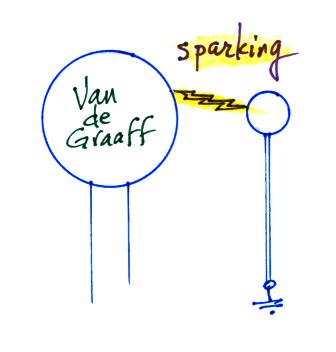 |
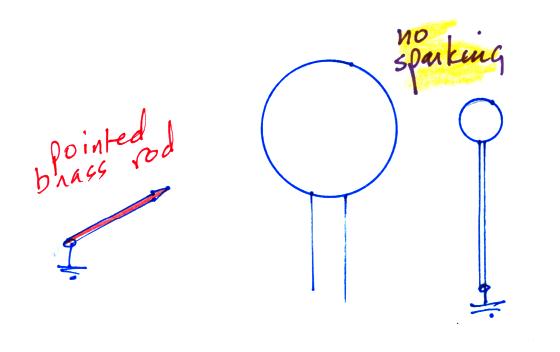 |
If a pointed, grounded rod is brought
to within about 20 centimeters of the Van de Graaff, the
sparking to the grounded round ball stops. The pointed
rod is drawing off electricity from the generator before
sufficient charge is able to build up and spark across to
the grounded ball.
The terms drawing off or
throwing off electricity simply refer to whether current
is flowing to or from the pointed rod.
Franklin originally thought a lightning rod would
work in this way.
2. Suggestion and proof that thunderstorm and laboratory electricity were the same.
Franklin saw many similarities between the electricity used in his experiments and lightning.
Both produce light, and the colors of light are similar. Crooked channels. Swift motion. Being conducted by metals. Crack or noise produced during discharge. "Subsisting" in water or ice. "Rending" bodies as current passes through. Killing animals. Melting metals. Catching inflammable materials on fire. Sulphurous smell.
He wondered whether lightning wasn't just a much larger scale form of the same phenomenon and proposed the following experiment (the Sentry box experiment was described in a July 29, 1750 letter)
"To determine the question, whether
the clouds that contain lightning are electrified or not, I
would propose an experiment to be tried where it may be done
conveniently. On the top of
some high tower or steeple, place a kind of sentry-box big
enough to contain a man and an electrical stand. From the middle of the stand let
an iron rod rise and pass bending out of the door, and then
upright 20 or 30 feet, pointed very sharp at the end. If the electrical stand be kept
clean and dry a man standing on it when such clouds are
passing low, might be electrified and afford sparks, the rod
drawing fire to him from a cloud. If
any danger to the man should be apprehended (though I think
there would be none) let him stand on the floor of his box,
and now and then bring near to the rod the loop of a wire
that has one end fastened to the leads, he holding it by a
wax handle; so the sparks, if the rod is electrified, will
strike from the rod to the wire, and not affect him.”
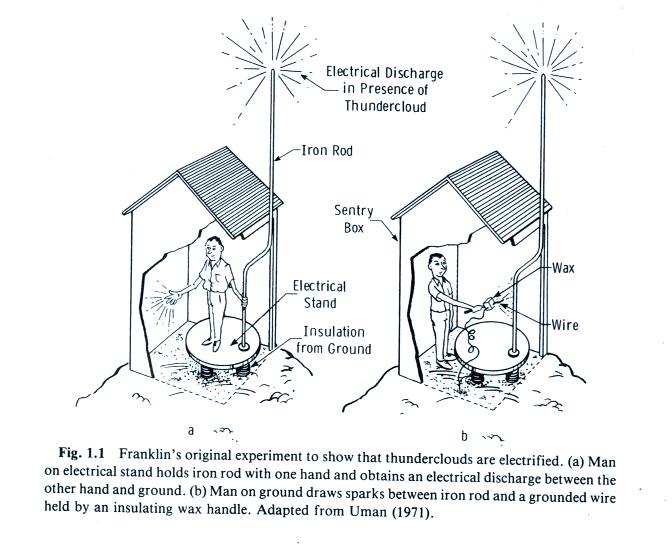
The experiment was performed for the
first time on May 10, 1752 in Marly-la-Ville (near Paris) by
a retired dragoon name Coiffier (Thomas Francois Dalibard, a
naturalist, was absent). Dalibard read an account of
the experiment to the French Academie des Sciences on May
13, 1752. You can read a short description of the experiment
(in French) on the Commune
de
Marly La Ville website.
The experiment was widely repeated
LeMonnier held a 5 m wooden pole with iron wire windings while standing on pitchcake. Sparks were seen coming from his hands and face.
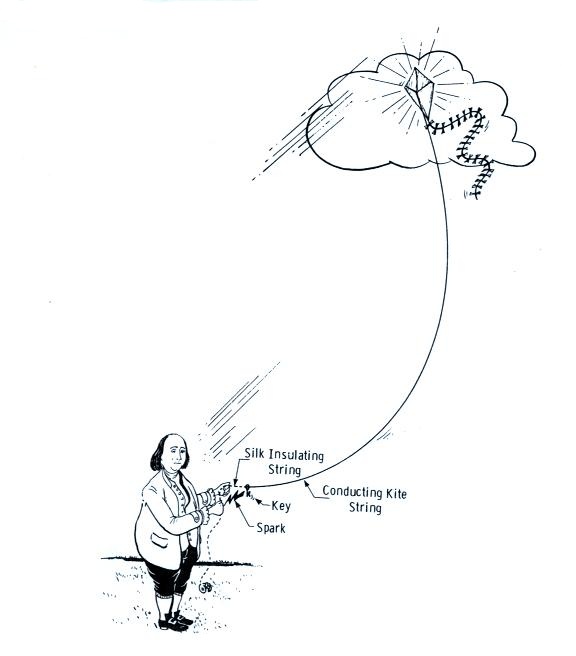
The experiment is thought to have been conducted in June, 1752, but the exact date and location were never recorded. Details of the experiment were sent to Collinson in a letter dated Oct. 19, 1752.
Other people began to repeat the experiment using rockets (mortars) and balloons. In June 1753 de Romas used a kite with a 240 m cord wrapped with violin wire. He produced 20 cm long sparks. Apparently he was later able to produce 3 m long sparks!
The strength of the electricity was often judged by simulating the muscles of animals and observing their reaction.
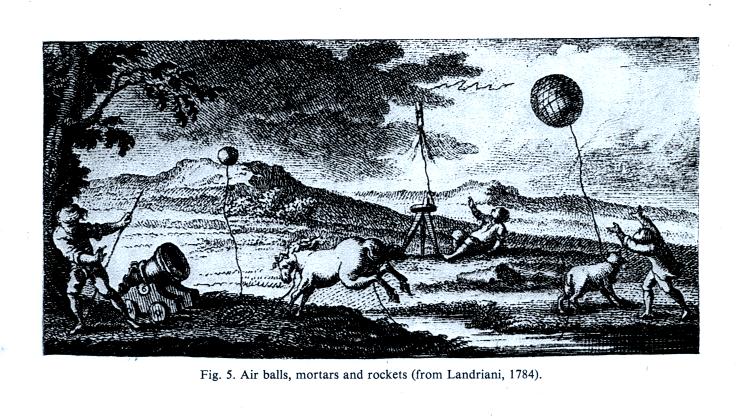
Both the sentry box experiment and the kite experiment are very dangerous. If lightning were to strike the metal pole or the kite or balloon, the person at the bottom would likely be killed. This did eventually happen
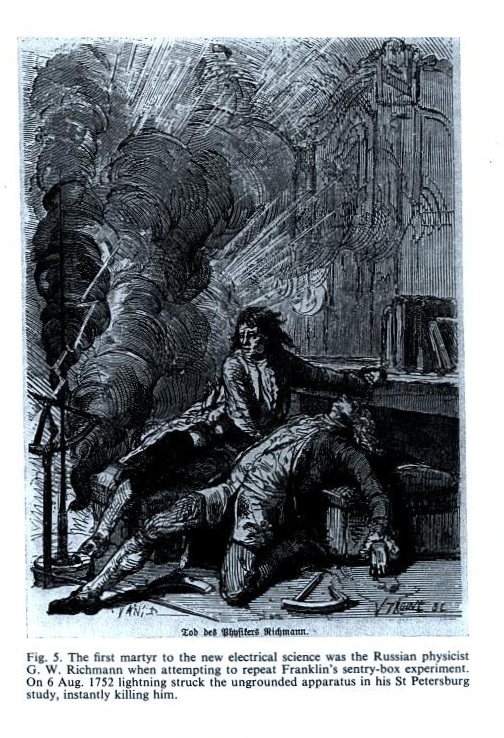
3. Invention of lightning rods
“There is
something however in the experiments of points, sending
off, or drawing on, the electrical fire, which has not
been fully explained, and which I intend to supply in my
next. For the doctrine of points is very curious, and the
effect of them truly wonderful; and, from what I have
observed on experiments, I am of opinion,
that houses, ships, and even towns and churches may be
effectually secured from the stroke of lightning by their
means; for if, instead of the round balls of wood or
metal, which are commonly placed on the tops of the
weather-cocks, vanes or spindles of churches, spires, or
masts, there should be put a rod of ion 8 or 10 feet in
length, sharpen’d gradually to a point like a needle, and
gilt to prevent rusting, or divided into
a number of points, which would be better – the electrical
fire, would, I think, be drawn out of a cloud silently,
before it could come near enough to strike; only a light
would be seen at this point, like the sailors corpusante.”
and my favorite quotation:
"It has pleased God in his goodness to mankind, at
length to discover to them the means of securing their
habitations and other buildings from mischief by
thunder and lightning ..."
Here Franklin was anticipating and seeking
to counter opposition from religious authorities
(lightning was considered by many to be a form of
divine retribution).
Metal (nail) rods were often linked together as shown below (some fragments of Franklin's original lightning rods still exist, in one case inside a building and next to dry wooden beams). The links tended to rupture.

how does the rod work
what material should be used
termination in air
grounding
attachment to structure
height above the structure
area protected by the rod
"Lightning had been regarded as a divine expression, a manifestation against which there could be no possible protection, except prayer and the ringing of church bells. Such bells cast in mediaeval times often bore the legend "Fulgura frango" ("I break up the lightning"). With the passage of time, however, it was realized that bell ringing during a storm was a very hazardous remedy, especially for the ringer on the ropes becuase so many were killed by the very stroke they attempted to disperse." In 33 years of lightning strokes on 386 church steeples 103 bell-ringers were killed. (Ref (2))
A showdown took place in the Piazza in Siena Italy in Spring 1777. One side doubted the electrical nature of lightning and the efficacy of lightning rods. A second, more progressive side, had ordered a lightning rods to be installed on the cathedral and the tower of City Hall (facing the plaza where the famous Palio is run).

"On the afternoon of 18 April clouds began to form, distant thunder was heard, and the Siennese began moving to their Piazza with all eyes focused on the lightning rod tip. At about five o'clock - lightning struck. A ball of fire, accompanied by sparks, smoke, and an odor of sulphur ran the full length of the tower and disappeared into the ground leaving the tower unharmed." (source of the image above)
Lightning rods were quickly adopted throughout Italy (and also in other Catholic countries because they were approved by The Pope)
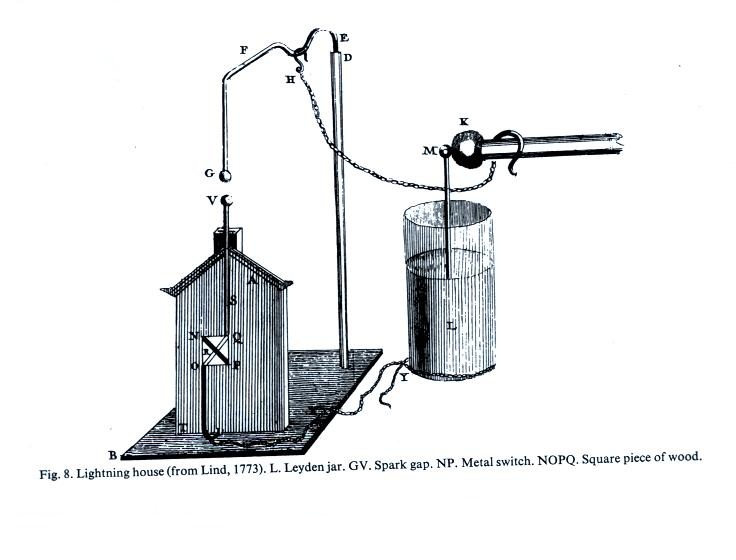
A lightning house, a common demonstration of the efficacy of lightning rods. The small square in the side of the house is filled with gunpowder. When a spark is delivered to Point V it will travel down Conductor S, spark across the Gap Q-O and ignite the gunpowder. If a metal connection is made between Q and O, the current will flow through a metal conductor all the way to the ground. There won't be any sparking and the gunpowder won't be ignited.
May 1752 Congratulations from the King of France
July 1753 Master of Arts from Harvard University
Sept. 1753 Master of Arts from Yale University
Nov. 1753 Copeley Gold Medal, Royal Society, London
April 1756 Fellow (w/o fee) of the Royal Society
Feb. 1759 University of St. Andrews Scotland Doctor of Civil and Canon Laws
April 1762 Oxford Doctor of Civil Laws
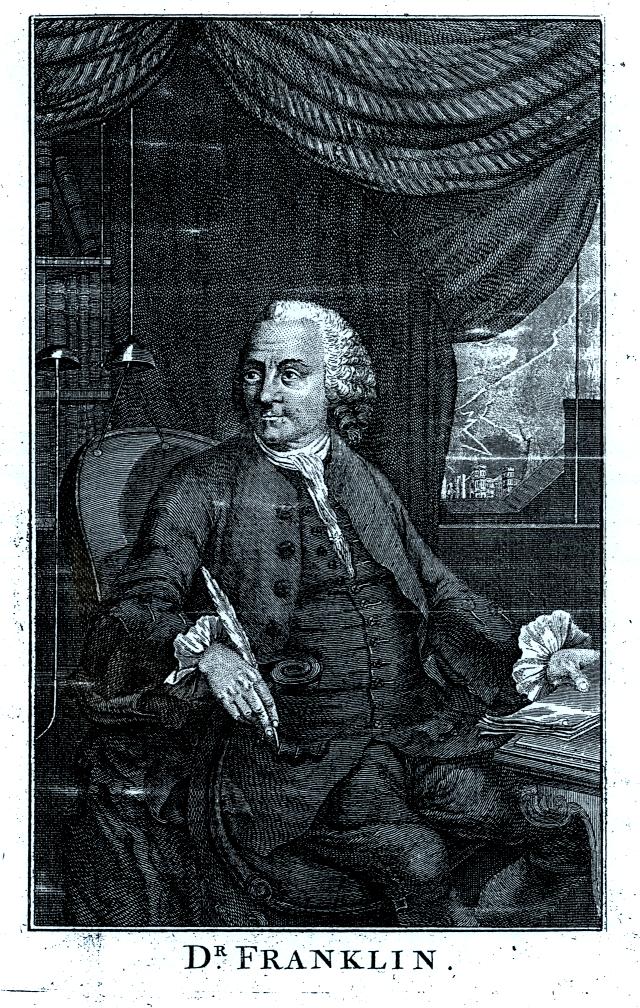
Note the Franklin chimes (center left) and a grounded lightning rod (window)
A Franklin chimes was demonstrated in class. The photograph below shows the apparatus that was used.
It consists of two bells. The left bell is connected to ground. The right bell was insulated from ground on a teflon support. A pointed rod extended upward from the right bell. The point at the end of the rod was placed 3 or 4 inches from the top of the Van de Graaff generator. A small metal ball (actually a piece of rod) was suspended on an insulating string midway between the two bells.
When the Van de Graaff was turned on the metal ball began to swing between the two bells. The operation is explained in the following series of pictures.
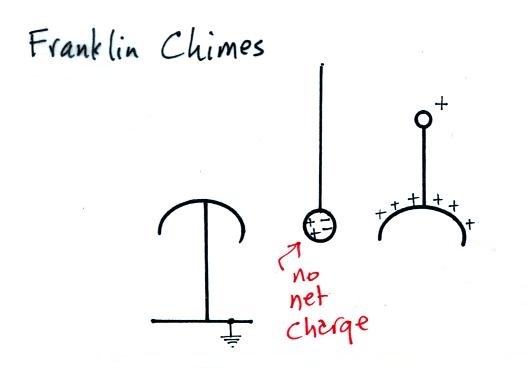
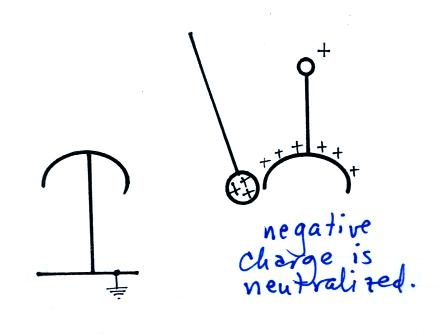
The metal ball is attracted to the right bell. Contact with the bell neutralizes the negative charge on the ball. The ball is then repelled by the positive charge on the bell.
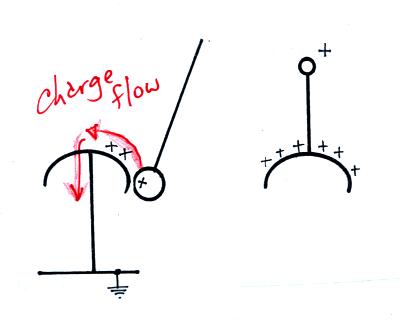
Once the ball touches the grounded bell, the positive charge flows to ground.
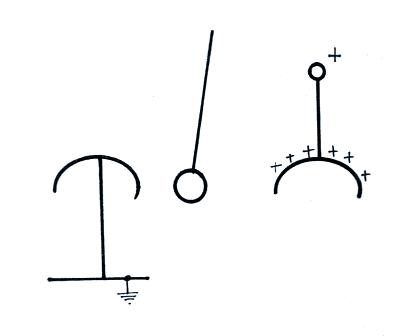
The ball is again uncharged. The whole process repeats itself. The overall effect of the swinging ball is to transport charge from the right bell to ground.
The Franklin chimes demonstration was followed by a demonstration of Volta's Hailstorm.
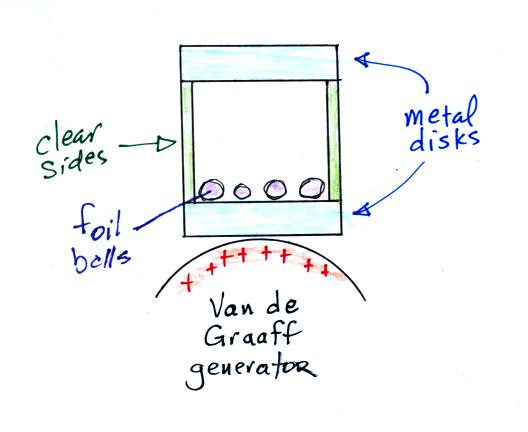
When the generator is turned on, the foil balls which are in electrical contact with the generator dome acquire some charge (assumed to be positive).
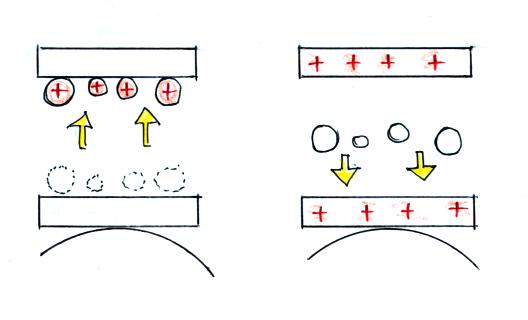
The balls are repelled by the bottom electrode and travel up to the top metal disk (left figure above). They transfer their charge to the top disk and then fall back to the bottom disk (right figure). The positive charge in the top plate then flows to ground. The foil balls again acquire charge from the bottom disk and the whole process repeats itself.
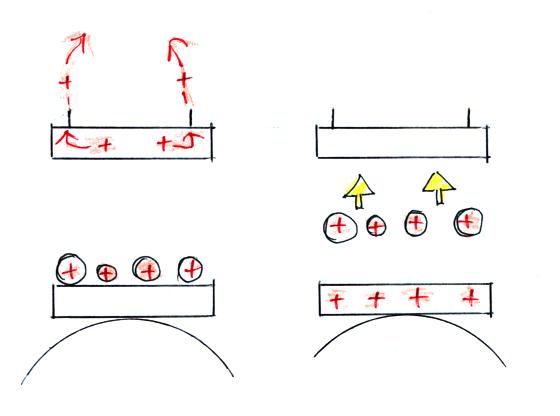
The apparatus will sometimes operate even when the top plate is not directly connected to ground. The charge on the top disk bleeds off off the corners of the top plate and through the pieces of wire connected to the plate (the pointed pieces of wire are "throwing off" the electrical charge; the charge eventually travels to ground and completes the circuit). The foil balls again acquire charge from the bottom disk and the whole process repeats itself.
Here's a video of Volta's Hailstorm in action.
References
(1) H. Prinz, Lightning in History, Ch. 1 in Lightning Vol. 1, ed. by R.H. Golde, Academic Press, London, 1977.
(2) B. Dibner, Benjamin Franklin, Lightning, Ch. 2 in Lightning Vol. 1, ed. by R.H. Golde, Academic Press, London, 1977.
(3) E.P. Krider, "Benjamin Franklin and Lightning Rods," Physics Today, 42-48, Jan., 2006.
(4) I. Gonta and E.. Williams, "A Calibrated Franklin Chimes", J. Geophys. Res., 99, 10671-10677, 1994.
The links above will take you to an online e-journal copy of the article available from the University of Arizona Library; it may not be available to you if you use an off-campus computer.